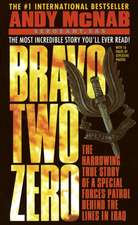Military Leadership and Counterinsurgency: The British Army and Small War Strategy Since World War II
Autor Victoria Nolanen Limba Engleză Hardback – 12 dec 2011
Preț: 773.81 lei
Preț vechi: 1112.93 lei
-30% Nou
Puncte Express: 1161
Preț estimativ în valută:
148.06€ • 154.59$ • 122.55£
148.06€ • 154.59$ • 122.55£
Carte disponibilă
Livrare economică 14-28 martie
Preluare comenzi: 021 569.72.76
Specificații
ISBN-13: 9781848857742
ISBN-10: 1848857748
Pagini: 320
Ilustrații: 10 line
Dimensiuni: 138 x 216 x 36 mm
Greutate: 0.52 kg
Editura: Bloomsbury Publishing
Colecția I.B.Tauris
Locul publicării:London, United Kingdom
ISBN-10: 1848857748
Pagini: 320
Ilustrații: 10 line
Dimensiuni: 138 x 216 x 36 mm
Greutate: 0.52 kg
Editura: Bloomsbury Publishing
Colecția I.B.Tauris
Locul publicării:London, United Kingdom
Notă biografică
Victoria Nolan is a Coordination Assistant for the Institute for Social and Economic Research (ISER) at the University of Essex. She holds a PhD in War Studies from KCL and an MSc in Global Security from Cranfield University at the Defence Academy at Shrivenham.
Cuprins
Chapter One - IntroductionMilitary Leadership and Organisational Culture BackgroundOutlineScope and Case StudiesChapter Two - The Legacy of Imperial PolicingPre-World War One: Small Wars and Learning LeadersSir Garnet WolseleyLords Roberts and KitchenerLeaders and DoctrineThe First World War and the Learning CycleThe Inter-War YearsAmritsar, 1919Ireland, 1919-1921Inter-War Small Wars DoctrineThe Palestine MandateThe Second World War and the Learning CycleBurma and the ChinditsPalestine, 1945-1947Chapter Three - The Malayan Emergency, 1948-1960 Leadership Characteristics and Cultural Evolution The leaders' role in embedding and transmitting culturePhase One, 1948-50Phase Two, 1950-52 Phase Three, 1952-54Phase Four, 1954-60Doctrine, Training, & the Institutionalisation of Learning Leadership & the Perpetuation of Culture in MalayaCharismatic Leadership Enabling ConditionsSupport NetworksContinuity of ExperienceChapter Four - Kenya and the Mau Mau Uprising, 1952-1956Leadership Characteristics and Cultural EvolutionThe leaders' role in transmitting and embedding culturePhase One, October 1952-June 1953Phase Two, June 1953-April 1954Phase Three, April 1954-January 1955Phase Four, January 1955-November 1956Doctrine, Training, & the Institutionalisation of LearningLeadership and the Perpetuation of Culture in Kenya Charismatic Leadership Enabling ConditionsSupport NetworksContinuity of ExperienceAppendix A: Erskine's DirectiveChapter Five - Cyprus, 1955-1960Leadership Characteristics and Cultural EvolutionThe leaders' role in transmitting and embedding culturePhase One, April 1955-October 1955Phase Two, October 1955-November 1957Phase Three, November 1957-August 1960Doctrine, Training, & the Institutionalisation of LearningLeadership and the Perpetuation of Culture in CyprusCharismatic LeadershipEnabling ConditionsSupport NetworksContinuity of ExperienceChapter Six - ConclusionFindingsEmbedding and Transmitting CultureCharismatic LeadershipSupportContinuity of ExperienceSummaryShort and Long Term Learning CyclesLong-Term LearningShort-Term, Campaign-Specific LearningAnnex A: Timeline of EventsAnnex B: A Note on Conventional Warfare ThinkingAnnex C: Glossary of TermsBibliography










